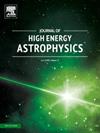Greybody factor and accretion disk around regular black holes in Verlinde emergent gravity
IF 10.2
4区 物理与天体物理
Q1 ASTRONOMY & ASTROPHYSICS
引用次数: 0
Abstract
Verlinde's emergent gravity (VEG) posits that gravity is not a fundamental force but an emergent phenomenon arising from the entropic nature of spacetime. Building on this concept, recent research has introduced a novel class of black holes within the VEG framework, linking the effects of apparent dark matter to baryonic matter distributions. In this study, we investigate the greybody factors and accretion disk properties around a Simpson–Visser Minkowski core black hole solution in VEG. We derive the effective potential and rigorous bounds for this black hole model, showing that various model parameters significantly influence both the effective potential and greybody factor bounds. Notably, increasing parameters associated with emergent gravity heightens the peak of the effective potential while reducing greybody factor bounds, offering insights into how VEG modifies black hole radiation. Through detailed density plots, we highlight potential observational signatures that could distinguish black holes governed by emergent gravity from those predicted by traditional theories. Using the established Novikov-Thorne model, we explore thin accretion disks around this unique black hole solution, uncovering a strong correlation between disk dynamics and VEG parameters. Our results indicate that VEG induces vertical stretching and outward expansion in the accretion disk structure. We present a comprehensive analysis of the accretion disk by examining both direct and secondary images at varying radial distances and observational angles, offering new perspectives on how emergent gravity influences observable black hole environments.
Verlinde涌现引力中规则黑洞周围的灰体因子和吸积盘
Verlinde的涌现引力(VEG)假设引力不是一种基本的力,而是一种由时空的熵本质产生的涌现现象。在这个概念的基础上,最近的研究在VEG框架内引入了一类新的黑洞,将表观暗物质的影响与重子物质分布联系起来。在这项研究中,我们研究了VEG中Simpson-Visser - Minkowski核心黑洞解周围的灰体因子和吸积盘性质。我们推导了该黑洞模型的有效势和严格界,表明不同的模型参数对有效势和灰体因子界都有显著的影响。值得注意的是,增加与涌现引力相关的参数会提高有效势的峰值,同时降低灰体因子界限,从而为VEG如何改变黑洞辐射提供了见解。通过详细的密度图,我们突出了可能的观测特征,这些特征可以区分由新兴引力控制的黑洞与传统理论预测的黑洞。利用已建立的Novikov-Thorne模型,我们探索了这个独特黑洞解周围的薄吸积盘,揭示了盘动力学与VEG参数之间的强相关性。我们的结果表明,VEG诱导吸积盘结构的垂直拉伸和向外膨胀。我们通过检查不同径向距离和观测角度的直接和二次图像,对吸积盘进行了全面的分析,为新兴引力如何影响可观测的黑洞环境提供了新的视角。
本文章由计算机程序翻译,如有差异,请以英文原文为准。
求助全文
约1分钟内获得全文
求助全文
来源期刊

Journal of High Energy Astrophysics
Earth and Planetary Sciences-Space and Planetary Science
CiteScore
9.70
自引率
5.30%
发文量
38
审稿时长
65 days
期刊介绍:
The journal welcomes manuscripts on theoretical models, simulations, and observations of highly energetic astrophysical objects both in our Galaxy and beyond. Among those, black holes at all scales, neutron stars, pulsars and their nebula, binaries, novae and supernovae, their remnants, active galaxies, and clusters are just a few examples. The journal will consider research across the whole electromagnetic spectrum, as well as research using various messengers, such as gravitational waves or neutrinos. Effects of high-energy phenomena on cosmology and star-formation, results from dedicated surveys expanding the knowledge of extreme environments, and astrophysical implications of dark matter are also welcomed topics.
 求助内容:
求助内容: 应助结果提醒方式:
应助结果提醒方式:


